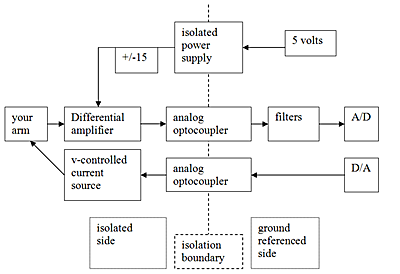ECE 5030
Skin Impedance
Introduction.
In this assignment you will build a device to measure the impedance of your skin. Any circuit which you attach to your body must be completely isolated from earth ground and the 110 volt grid. In the context of phychological research, you can find out more information using the phrase galvanic skin response.
Procedure
You will need an isolated power supply, an analog signal isolator, a differential amplifier and analog filters (as before) but will add an isolated current generator..
- A possible differential amplifier circuit. In the schematic, ignore the power supply opamp on the left. The input to the diff-amp has a lowpass filter. The opamp to the right is a highpass filter. The INA121 is a good, low power diffamp.
- We will use a dc powered, transformer isolated power supply, the DCP010515, to power the diffamp and current source.
- Both analog isolators will be either a Clare LOC110 (see appnote 107) or Vishay IL300 (see appnote 50).
A block diagram is shown below.

Rather than testing the circuit with actual electrodes on the arm, test with this circuit:

More information:
Skin impedance from 1 Hz to 1 MHz, Rosell, J. Colominas, J. Riu, P. Pallas-Areny, R. Webster, J.G. , IEEE Transactions on Biomedical Engineering, 1988, Volume: 35, Issue: 8 pages 649-651. (cornell library link)
Electrical impedance of human skin, E. Kinnen, Medical and Biological Engineering and Computing, SSN 0140-0118 (Print) 1741-0444 (Online) Issue Volume 3, Number 1, January, 1965 (CU link)
Wearable EDA Sensor Gloves using Conducting Fabric and Embedded System, Y. B. Lee, S. W. Yoon, C. K. Lee, M. H. Lee (pdf)
Assignment
- Build a circuit based on the block diagram above. You will need to do a fair amount of experimenting. For testing, use a drive a model on the skin impedance as shown above. You probably want to limit the current source to a few dozen microamps.
- Once you can characterize the impedance of the test circuit, connect your arm to the system and measure the impedance of your arm.
- Try to cause the impedance of your arm to change by actions or thoughts.
- Use the USB-6008 to connect the circuit to your computer.
Write a matlab program to:
- Produce a sine wave from the sound port and drive the constant current source.
- Determine the phase and magnitude of the resulting voltage
- Draw a bode plot for your arm.
Your written lab report should include the sections mentioned in the policy page, and :
- Relationship between skin impedance and emotional state (see also: galvanic skin response or sympathetic skin response).
- Observations concerning biological effects, such as electrode position or other effects.
June 2009 . Copyright Cornell university


